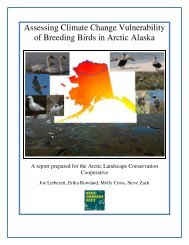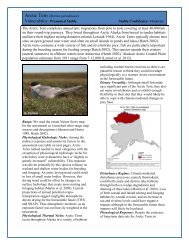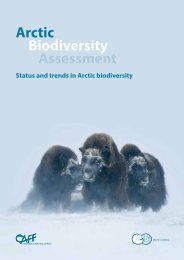Permafrost Terrain Stability and Thermokarst Monitoring: - Arctic LCC
Permafrost Terrain Stability and Thermokarst Monitoring: - Arctic LCC
Permafrost Terrain Stability and Thermokarst Monitoring: - Arctic LCC
Create successful ePaper yourself
Turn your PDF publications into a flip-book with our unique Google optimized e-Paper software.
sites where were successfully established, <strong>and</strong> shrubs were taller <strong>and</strong> more dominated by tall<br />
shrub species (for example, willow <strong>and</strong> shrub birch) than in other areas. The authors<br />
speculated that tree <strong>and</strong> shrub advancement in the tundra depends on well-drained<br />
microsites, such as microsites on thaw-pond banks, <strong>and</strong>, therefore, that treeline advancement<br />
is contingent on further degradation of existing permafrost.<br />
97. Lougheed, V.L., Butler, M.G., McEwen, D.C., <strong>and</strong> Hobbie, J.E., 2011, Changes in<br />
tundra pond limnology—Re-sampling Alaskan ponds after 40 years: Ambio, v. 40,<br />
no. 6, p. 589–599.<br />
This paper documents the resampling of several ponds near Barrow, Alaska, that were<br />
studied intensively in the 1970s, <strong>and</strong> found that the ponds had undergone a change in their<br />
physical, chemical, <strong>and</strong> biological characteristics. Differences included higher daily mean<br />
<strong>and</strong> maximum pond temperatures, higher concentrations of ammonia, nitrate, <strong>and</strong> soluble<br />
reactive phosphorus, <strong>and</strong> a marginal increase in phytoplankton biomass. The authors noted<br />
that it is difficult to make any broad statements regarding the effects of climate on these<br />
ponds given the small amount of data, <strong>and</strong> suggested that these ponds represent a unique <strong>and</strong><br />
valuable long-term dataset <strong>and</strong> should be sampled more frequently <strong>and</strong> maintained as<br />
Barrow exp<strong>and</strong>s.<br />
98. MacLean, R., Oswood, M.W., Irons, J.G., <strong>and</strong> McDowell, W.H., 1999, The effect of<br />
permafrost on stream biogeochemistry—A case study of two streams in the Alaskan<br />
(USA) taiga: Biogeochemistry, v. 47, no. 3, p. 239–267.<br />
This paper examines the effect of permafrost on stream chemistry by analyzing soils<br />
chemistry in shallow organic soils <strong>and</strong> groundwater derived from springs <strong>and</strong> wells.<br />
Extensive permafrost led to a greater hydrograph response to spring thaw <strong>and</strong> summer<br />
storms, as well as a stronger signature of organic soil chemistry in the stream. Nitrogen<br />
cycling appeared to occur independent of permafrost extent, as indicated by limited<br />
correlations between nitrogen <strong>and</strong> discharge. A conceptual model is provided, indicating<br />
different flowpaths through organic <strong>and</strong> mineral soils, depending on permafrost extent.<br />
99. Mackay, J.R., 1970, Disturbances to the tundra <strong>and</strong> forest tundra environment of the<br />
western <strong>Arctic</strong>: Canadian Geotechnical Journal, v. 7, no. 4, p. 420–432.<br />
The e terms thermokarst <strong>and</strong> thermo-erosion are defined, <strong>and</strong> differences between these two<br />
terms are highlighted, particularly the importance of thermal degradation <strong>and</strong> vertical<br />
subsidence of thermokarst versus the importance of thermal degradation, mechanical<br />
erosion, <strong>and</strong> lateral expansion under the influence of flowing water for thermo-erosion. The<br />
author uses multiple examples from Northern Canada to explain his views of these<br />
processes. Examples include the impact of man-made disturbances from seismic<br />
exploration, a wildfire, a seepage in a channel, <strong>and</strong> a dog kennel patch on underlying<br />
permafrost. Field-measured rates of thermokarst <strong>and</strong> thermo-erosion are reported for each of<br />
these examples.<br />
100. Mackay, J.R., 1972, The world of underground ice: Annals of the Association of<br />
American Geographers, v. 62, no. 1, p. 1–22.<br />
This paper provides an overview of the types <strong>and</strong> forms of ground ice. The paper includes a<br />
map of permafrost distribution across the northern hemisphere, <strong>and</strong> a schematic indicating<br />
how different processes lead to different forms of ground ice. The paper discusses many<br />
forms of ground ice <strong>and</strong> how they originate <strong>and</strong> thaw, <strong>and</strong> describes the formation of three<br />
pingos on the coastal plain at length. The potential for ice to exist beneath the ocean is also<br />
noted.<br />
36








